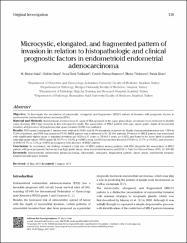| dc.contributor.author | Naki, Mehmet Murat | |
| dc.contributor.author | Oran, Gülbin | |
| dc.contributor.author | Tetikkurt, Seza Ümit | |
| dc.contributor.author | Sönmez, Cavide Fatma | |
| dc.contributor.author | Türkmen, İlknur | |
| dc.contributor.author | Köse, Faruk | |
| dc.date.accessioned | 10.07.201910:49:13 | |
| dc.date.accessioned | 2019-07-10T20:01:33Z | |
| dc.date.available | 10.07.201910:49:13 | |
| dc.date.available | 2019-07-10T20:01:33Z | |
| dc.date.issued | 2017 | en_US |
| dc.identifier.citation | Naki, M. N., Oran, G., Tetikkurt, S. Ü., Sönmez, C. F., Türkmen, İ. ve Köse, F. (2017). Microcystic, elongated, and fragmented pattern of invasion in relation to histopathologic and clinical prognostic factors in endometrioid endometrial adenocarcinoma. Journal of the Turkish-German Gynecological Association, 18(3), 139-142. https://dx.doi.org/10.4274/jtgga.2017.0016 | en_US |
| dc.identifier.issn | 1309-0399 | |
| dc.identifier.issn | 1309-0380 | |
| dc.identifier.uri | https://dx.doi.org/10.4274/jtgga.2017.0016 | |
| dc.identifier.uri | https://hdl.handle.net/20.500.12511/3334 | |
| dc.description | WOS: 000423954800008 | en_US |
| dc.description | PubMed ID: 28890428 | en_US |
| dc.description.abstract | Objective: To investigate the association of microcystic, elongated, and fragmented (MELF) pattern of invasion with prognostic factors in endometrioid endometrial adenocarcinoma (EEA). Material and Methods: Stained tissue sections from 83 cases of EEA operated by the same gynecologic oncologist were reviewed to identify cases showing MELF-type invasion in this retrospective study. The association of MELF pattern with age, tumor grade, depth of myometrial invasion, and presence of lymphovascular space invasion (LVSI) was analyzed. Results: FIGO grade 2 and grade 1 tumors were evident in 53.0% and 38.6% of patients, respectively. Depth of myometrial invasion was <50% in 72.0% of patients, and LVSI was absent in 77.1%. MELF pattern was confirmed in 35 (42.2%) patients. Presence of MELF pattern was associated with significantly higher mean +/- standard deviation age (62.9 +/- 6.9) years vs. 58.9 +/- 9.1 years, p=0.033), and found to be more likely in patients with high-grade tumor (FIGO grade III; 85.7% vs. 14.3%, p<0.001), deep (>= 50%) myometrial invasion (78.3% vs. 21.7%, p<0.001), and presence of LVSI (94.7% vs. 5.3%, p<0.001) as compared with absence of MELF pattern. Conclusion: In conclusion, our findings revealed a high rate of MELF pattern among patients with EEA alongside the association of MELF pattern with poor prognostic factors such as high grade tumor, deep myometrial invasion, and LVSI. | en_US |
| dc.language.iso | eng | en_US |
| dc.publisher | Galenos Yayıncılık | en_US |
| dc.rights | info:eu-repo/semantics/openAccess | en_US |
| dc.subject | Endometrioid Endometrial Adenocarcinoma | en_US |
| dc.subject | Microcystic | en_US |
| dc.subject | Elongated | en_US |
| dc.subject | Fragmented Pattern | en_US |
| dc.subject | Tumor Grade | en_US |
| dc.subject | Myometrial Invasion | en_US |
| dc.subject | Lymphovascular Space Invasion | en_US |
| dc.title | Microcystic, elongated, and fragmented pattern of invasion in relation to histopathologic and clinical prognostic factors in endometrioid endometrial adenocarcinoma | en_US |
| dc.type | article | en_US |
| dc.relation.ispartof | Journal of the Turkish-German Gynecological Association | en_US |
| dc.department | İstanbul Medipol Üniversitesi, Tıp Fakültesi, Cerrahi Tıp Bilimleri Bölümü, Tıbbi Patoloji Ana Bilim Dalı | en_US |
| dc.authorid | 0000-0002-6708-7791 | en_US |
| dc.identifier.volume | 18 | en_US |
| dc.identifier.issue | 3 | en_US |
| dc.identifier.startpage | 139 | en_US |
| dc.identifier.endpage | 142 | en_US |
| dc.relation.publicationcategory | Makale - Uluslararası Hakemli Dergi - Kurum Öğretim Elemanı | en_US |
| dc.identifier.doi | 10.4274/jtgga.2017.0016 | en_US |
| dc.identifier.scopusquality | Q3 | en_US |


















